History of Rajasthan
The state of Rajasthan in India has a history dating thousands of years. It was the site of the Indus Valley Civilization. The early medieval period saw the rise of the Mughal Empire. The Mughals granted high positions to Rajput rulers who allied with them. However, some Rajput kingdoms did not accept Mughal suzerainty and were constantly at war with them. The Mughal rule effectively ended in the 18th century, when the Maratha Empire conquered much of the subcontinent.
Maratha rule was soon replaced by British rule in India. The British also made allies out of local rulers, who were allowed to rule their princely states. This period was marked by famines and economic exploitation. However, the British period also saw the growth of railways, telegraph and modern industry in the region. After Indian Independence in 1947, the various princely states of Rajasthan were integrated into India.
Mythology
The written history of Rajasthan is found in the Vedas. It was earlier known as Matsya Janpada as Matsya Avtar was the first incarnation of Lord Vishnu in Virat Nagar, near Jaipur.
The Matsya avtar story is similar to Nooha's ( Nooha The second Prophet) story. After this In the Ramayana, the Character of Shabri belongs to Virat Nagar as She Married with the king of Virat Nagar, She was so beautiful that the king always worried to lose her thus he refused her to go out of home. Once A Kumbha Festival in Prayag (Allahabad U.P.) She demands to go there otherwise she shall attempt Suicide Finally the King was ready, but a condition is she must go early at morning before Sun arises.” She was ready Because Kumbha snan ( Bathing)- Festival in Prayag happens Only once in 12 years. King also went with her to ensure no other man can contact her. When she dipped in River Ganga she weeping out badly The goddess Ganga comes and ask why she was weeping. She replied,’’ Her husband does not allow to go out from home even when she wants to go temple, she needs nothing but only, serve God.” Then Goddess Ganga asked,” what can I do ?” She requested to Goddess Ganga for converting her to a hackle backed and unattractive So No one can disturb her to pray God. Goddess Ganga said, “Tathastu “(same will happen )(Amen). And She converted into a huckle backed and unattractive;Finally Got happy and in Ramavtar, Lord Rama Came and ate swat-berry (already tasted ). Another Discussion about Rajasthan is come in Mahabharat war Pandawastayed here when they had to live in Secret
Another Discussion comes in the time Maurya Chandragupta Mourya beat the Matsya Kingdom . The Followers of Matsya Kingdome still live in eastern Rajasthan as called Mina (Matsya is a Sanskrit word means Fish, in local language Meen means also fish ).
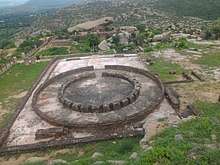
The old Matsya kingdom successor's went to forest, In the Criminal Tribe act they are forced to resettle down and now they belongs to schedule tribe status
History
The famous Mouryan king Ashoka made a stup in Virat Nagar. Which had demolished but remains is still After Mourya's area comes under Shaka and Kushan Kingdoms .
The history of human settlement in the west Indian state of Rajasthan dates back to about 5,000 years ago. This region was inhabited during great floods after the ice age as well. Area was known as Gujratra or Gurjar nation, early in the Muslim period.[1]
Ancient history
Stone Age tools dating from 5,000 to 2,00,000 years were found in Bundi and Bhilwara districts of the state.[2]
The ancient civilised history of Rajasthan goes back to 5,000 years ago when in the present day districts of Jhunjhunu and Sikar, along with other areas of Jaipur district bordering south Haryana, which formed the part of Vedic state of Brahmavarta along with districts of Mahendragarh and Rewari in Haryana, that Vedic seers started composing Vedic scriptures, which form part of Sanatan Dharma, the base of present-day Hinduism. Revered Saraswati and Drishadwati rivers formed the then Brahmavarta state. Drishadwati river is identified as the Vedic Drishadwati by Bhargava.[3] Parts of Rajasthan may have been occupied by the Indus Valley Civilization (Harappans). Excavations at Kalibanga in northern Rajasthan around 1998 revealed the existence of human settlements of Harappan times on the banks of a river that dried up later, which some people believe to be the Saraswati, archaeologists hope the Saraswati will unlock mysteries of the past. Rajasthan's geographic position in India has caused it to be affected by the expansionist efforts of various empires. It was a part of the Maurya Empire around 321-184 BCE.
Medieval period
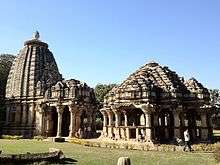
The Gurjar Pratihar Empire acted as a barrier for Arab invaders from the 8th to the 11th century. The chief accomplishment of the Gurjara-Pratihara Empire lies in its successful resistance to foreign invasions from the west, starting in the days of Junaid. Historian R. C. Majumdar says that this was openly acknowledged by the Arab writers. He further notes that historians of India have wondered at the slow progress of Muslim invaders in India, as compared with their rapid advance in other parts of the world. Now there seems little doubt that it was the power of the Gurjara Pratihara army that effectively barred the progress of the Arabs beyond the confines of Sindh, their only conquest for nearly 300 years.[4]
Prithviraj Chauhan defeated the invading Muhammad Ghori in the First Battle of Tarain in 1191. In 1192 CE, Muhammad Ghori decisively defeated Prithviraj at the Second battle of Tarain. After the defeat of Chauhan in 1192 CE, a part of Rajasthan came under Muslim rulers. The principal centers of their powers were Nagaur and Ajmer. Ranthambhore was also under their suzerainty. At the beginning of the 13th century, the most prominent and powerful state of Rajasthan was Mewar. The Rajputs resisted the Muslim incursions into India, although a number of Rajput kingdoms eventually became subservient to the Delhi Sultanate.
The Rajputs put up resistance to the Islamic invasions with their warfare and chivalry for centuries. The Rana's of Mewar led other kingdoms in its resistance to outside rule. Rana Hammir Singh, defeated the Tughlaq dynasty and recovered a large portion of Rajasthan. The indomitable Rana Kumbha defeated the Sultans of Malwa and Gujarat and made Mewar the most powerful Rajput Kingdom in India. The ambitious Rana Sanga united the various Rajput clans and fought against the foreign powers in India. Rana Sanga defeated the Afghan Lodi Empire of Delhi and crushed the Turkic Sultanates of Malwa and Gujarat. Rana Sanga then tried to create an Indian empire but was defeated by the first Mughal Emperor Babur at Khanua. The defeat was due to betrayal by the Tomar king Silhadi of Raisen. After Rana Sangas death there was no one who could check the rapid expansion of the Mughal Empire.[6]
Early Modern period (1526-1858 CE)
Mughal Conquests
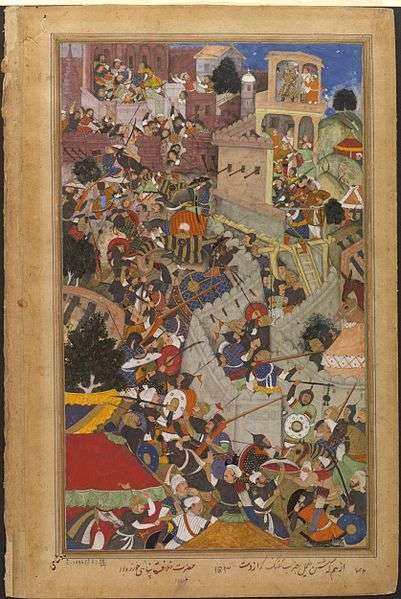
The Mughal Emperor Akbar expanded the empire into Rajputana in the 16th century CE. He laid siege to Chittor and defeated the Kingdom of Mewar in 1568. He also laid siege to Ranthambore and defeated the forces of Surjan Hada in the same year.
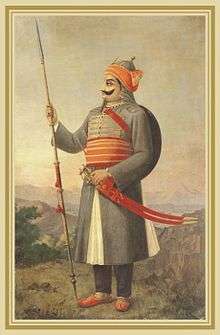
Akbar also arranged matrimonial alliances to gain the trust of Rajput rulers. He himself married the Rajput princess Jodha Bai. He also granted high offices to a large number of Rajput princes, and maintained cordial relations with them, such as Man Singh, one of the navaratnas. However, some Rajput rulers were not ready to accept Akbar's dominance and preferred to remain independent. Two such rulers were Udai Singh of Mewar and Chandrasen Rathore of Marwar. They did not accept Akbar's supremacy and were at constant war with him. This struggle was continued by Rana Pratap, the successor of Udai Singh. His army met with Akbar's forces at the Battle of Haldighati where he was defeated and wounded. Since then he remained in recluse for twelve years and attacked the Mughals from time to time.
When Rajput rulers lost to invaders during the medieval period, the women would commit jauhar, a form of ritual suicide by self-immolation on a pyre, as a gesture to protect their chastity and self-respect.
Mughal influence is seen in the styles of Rajput painting and Rajput architecture of the medieval period.
Maratha Empire
Since the early 1700s, the Maratha Empire began expanding northwards, led by Peshwa Baji Rao I of Pune. This expansion finally brought the newly founded Maratha Empire in contact with the Rajputs. Rajasthan saw many invasions by the Marathas, under military leadership of Holkars and Scindhias. Most of Rajputana passed under the control of the Maratha Empire and continued to pay tribute to Pune till the British East India Company replaced the Marathas as paramount rulers.[7]
British colonial period (1858-1947 CE)
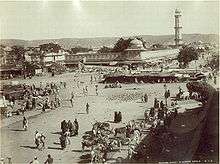
The arrival of the British East India Company in the region led to the administrative designation of some geographically, culturally, economically and historically diverse areas, which had never shared a common political identity, under the name of the Rajputana Agency. This was a significant identifier, being modified later to Rajputana Province and lasting until the renaming to Rajasthan in 1949. The Company officially recognized various entities, although sources disagree concerning the details, and also included Ajmer-Merwara, which was the only area under direct British control. Of these various areas, Marwar and Jaipur were the most significant in the early 19th century, although it was Mewar that gained particular attention from James Tod, a Company employee who was enamoured of Rajputana and wrote extensively, if often uncritically, of the people, history and geography of the Agency as a whole.
Alliances were formed between the Company and these various princely and chiefly entities in the early 19th century, accepting British sovereignty in return for local autonomy and protection from the Marathas. Following the Mughal tradition and more importantly due to its strategic location Ajmer became a province of British India, while the autonomous Rajput states, the Muslim state Tonk (princely state), and the Jat states Bharatpur, Dholpur were organized into the Rajputana Agency. In 1817–18, the British Government concluded treaties of alliance with almost all the states of Rajputana. Thus began the British rule over Rajasthan, then called Rajputana.
Post-independence (1947 CE - present)
.jpg)
The name of Rajasthan was probably popularized by Tod and during his lifetime some people believed that he had coined it.[8] Although he claimed that it was the classical name for the region, the term seems first to be documented in an inscription dating from 1708 and to have become popular by his time.[9]
It took seven stages to form Rajasthan as defined today. In March 1948 the Matsya Union consisted of Alwar, Bharatpur, Dhaulpur and Karauli was formed. Also, in March 1948 Banswara, Bundi, Dungarpur, Jhalawar, Kishangarh, Kota, Pratapgarh, Shahpura and Tonk joined the Indian union and formed a part of Rajasthan. In April 1948 Udaipur joined the state and the Maharana of Udaipur was made Rajpramukh. Therefore, in 1948 the merger of south and southeastern states was almost complete. Still retaining their independence from India were Jaipur State and the desert kingdoms of Bikaner, Jodhpur, and Jaisalmer. From a security point of view, it was claimed that it was vital to the new Indian Union to ensure that the desert kingdoms were integrated into the new nation. The princes finally agreed to sign the Instrument of Accession, and the kingdoms of Bikaner, Jodhpur, Jaisalmer and Jaipur acceded in March 1949. This time, the Maharaja of Jaipur, Man Singh II, was made the Rajpramukh of the state and Jaipur became its capital. Later in 1949, the United States of Matsya, comprising the former kingdoms of Bharatpur, Alwar, Karauli and Dholpur, was incorporated into Rajasthan. On January 26, 1950, 18 states of united Rajasthan merged with Sirohi to join the state leaving Abu and Dilwara to remain a part of Greater Bombay and now Gujarat.
Gurumukh Nihal Singh was appointed as first governor of Rajasthan. Hiralal Shastri was the first nominated chief minister of the state, taking office on 7 April 1949. He was succeeded by two other nominated holders of the office before Tika Ram Paliwal became the first elected chief minister from 3 March 1951.
In November 1956, under the provisions of the States Re-organisation Act, the erstwhile part 'C' state of Ajmer, Abu Road Taluka, former part of Sirohi princely state (which were merged in former Bombay), State and Sunel-Tappa region of the former Madhya Bharat merged with Rajasthan and Sirohi sub district of Jhalawar was transferred to Madhya Pradesh. Thus giving the existing boundary Rajasthan. Today with further reorganisation of the states of Uttar Pradesh, Madhya Pradesh and Bihar. Rajasthan has become the largest state of the Indian Republic.
The princes of the former kingdoms were constitutionally granted handsome remuneration in the form of privy purses and privileges to assist them in the discharge of their financial obligations. In 1970, Indira Gandhi, who was then the Prime Minister of India, commenced under-takings to discontinue the privy purses, which were abolished in 1971. Many of the former princes still continue to use the title of Maharaja, but the title has little power other than as a status symbol. Many of the Maharajas still hold their palaces and have converted them into profitable hotels, while some have made good in politics. The democratically elected Government runs the state with a chief minister as its executive head and the governor as the head of the state. Currently, including the new district of Pratapgarh, there are 33 districts, 105 sub-divisions, 37,889 villages, 241 tehsils and 222 towns in Rajasthan.
References
Notes
Citations
- Majumdar, R.C. (1994) [1952]. Ancient India. Motilal Banarsidass. p. 263. ISBN 978-81-208-0436-4.
- Pillai, Geetha Sunil (28 February 2017), "Stone age tools dating back 2,00,000 years found in Rajasthan", The Times of India
- Sudhir Bhargava, "Location of Brahmavarta and Drishadwati river is important to find earliest alignment of Saraswati river" Seminar, Saraswati river-a perspective, Nov. 20-22, 2009, Kurukshetra University, Kurukshetra, organised by: Saraswati Nadi Shodh Sansthan, Haryana, Seminar Report: pages 114-117
- Radhey Shyam Chaurasia (2002). History of Ancient India: Earliest Times to 1000 A. D. Atlantic Publishers & Distributors. pp. 207–208. ISBN 978-81-269-0027-5.
- Centre, UNESCO World Heritage. "Hill Forts of Rajasthan". UNESCO World Heritage Centre. Retrieved 2019-02-16.
- (Elliot's History of India, Vol. V)
- Naravane, M. S. The Rajputs of Rajputana: A Glimpse of Medieval Rajasthan. Retrieved 16 March 2014.
- Freitag, Jason (2009). Serving empire, serving nation: James Tod and the Rajputs of Rajasthan. Leiden: Brill. p. 36. ISBN 978-90-04-17594-5.
- Gupta & Bakshi (2008), p. 142
Bibliography
- Gupta, R. K.; Bakshi, S. R. (2008), Studies In Indian History: Rajasthan Through The Ages: The Heritage Of Rajputs, 1, Sarup & Sons, ISBN 9788176258418
Primary Sources
- Padmanābha, ., & Bhatnagar, V. S. (1991). Kanhadade Prabandha: India's greatest patriotic saga of medieval times : Padmanābha's epic account of Kānhaḍade. New Delhi: Voice of India.
Further reading
- Sharma, G. N., Bhatnagar, V. S., & University of Rajasthan. (1992). The Historians and sources of history of Rajasthan. Jaipur: Centre for Rajasthan Studies, University of Rajasthan.
